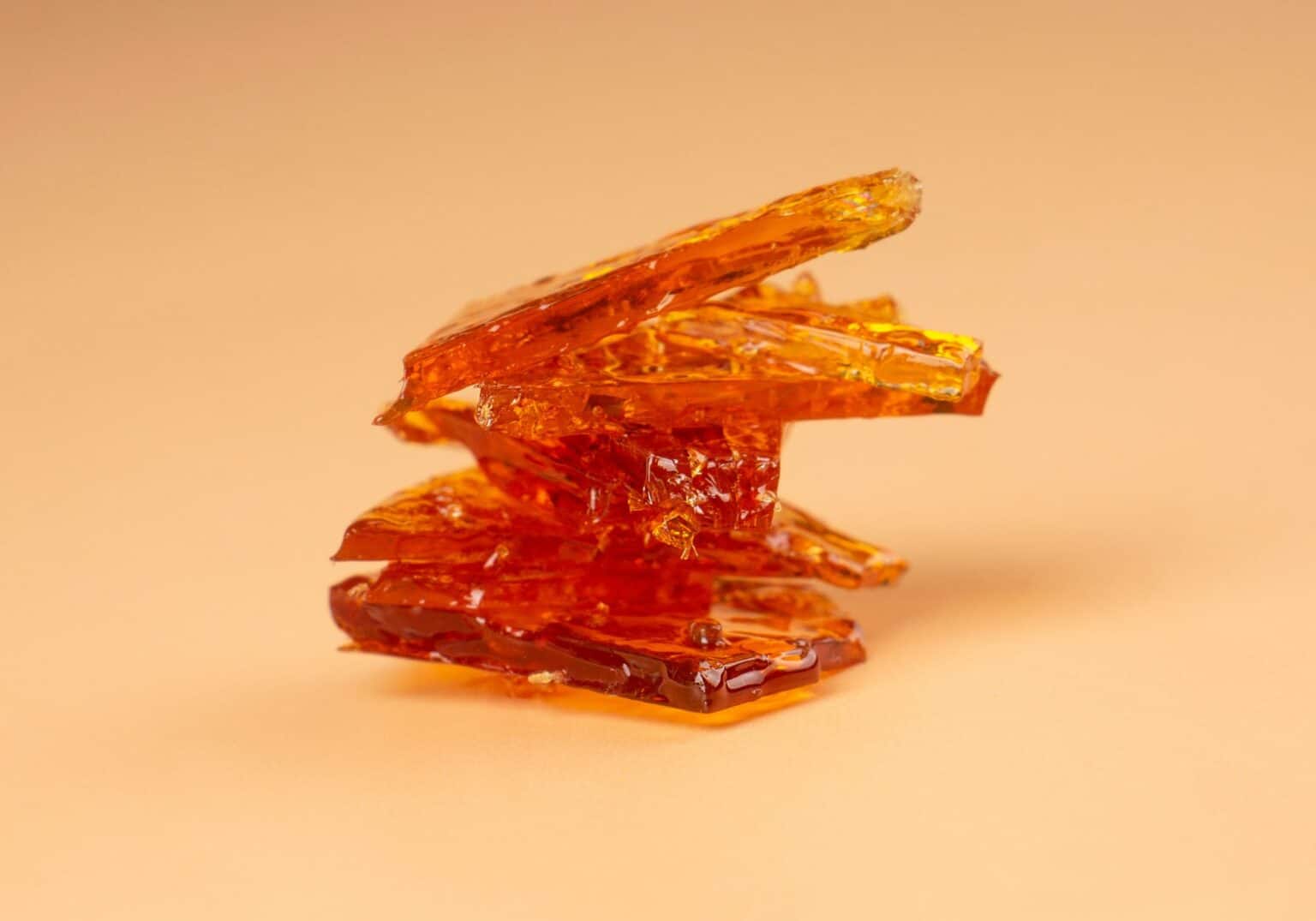Shatter, an emerging illicit substance, is swiftly making its presence known across the United States.
So, what is shatter weed? This term refers to a highly potent form of cannabis concentrate, also recognized as Butane Hash Oil (BHO). The name BHO comes from the use of butane, a liquid gas, to extract terpenes and cannabinoids from the cannabis plant. This process results in an exceptionally concentrated form of hash oil known for its powerful effects and efficiency in achieving a heightened state of euphoria.
Shatter is quickly becoming popular, especially in regions where cannabis use has been legalized. It appeals particularly to the youth, who are attracted to its striking appearance, the enhanced mood effects, and the unique experience of snapping the brittle substance apart before smoking it.
Here, we delve into the potential risks and side effects of shatter THC, offering a comprehensive look at its safety and the concerns surrounding its use.
What Is Shatter Weed?
Shatter represents the apex of marijuana potency and purity available today. However, as cannabis enthusiasts continue to explore and innovate, the prominence of shatter weed may evolve. For now, shatter fulfills the desires of the most dedicated cannabis connoisseurs, primarily because it contains THC levels at their zenith. THC, the principal psychoactive component in cannabis responsible for its euphoric effects, can soar to concentrations of 80 to 90 percent in shatter. By comparison, traditional marijuana buds typically feature THC content around 15 percent, underscoring shatter’s heightened potency. Consequently, experts advise that these highly concentrated extracts are better suited for experienced users rather than those new to cannabis.
The creation of shatter THC involves a process of chemical isolation from the cannabis plant, using a solvent like butane to draw out the compounds into an oil form. The subsequent steps in the process determine whether the concentrate becomes wax, budder, crumble, or shatter.
In terms of appearance, shatter resembles the translucent, amber-hued byproduct of a beehive, known for its brittle texture, which is where it gets its name. An additional filtration process is employed to eliminate fats and waxes, resulting in its clear look. This step also removes terpenes, the compounds that contribute to cannabis’s distinct aroma, making shatter’s appearance, consistency, and sensory attributes distinct from traditional marijuana forms.
Who Uses Shatter Cannabis Extract?
Shatter is often sought after by individuals looking for an intensified cannabis experience. It’s not typically the choice for novices or recreational first-time users; instead, it appeals more to those with a history of cannabis use who are searching for a new and more potent high. Shatter boasts a remarkably high cannabinoid content, ranging from 60% to 80%, with the purest forms reaching over 90%. The most premium shatter variants can even contain up to 99% cannabinoid content.
The allure of shatter lies in its ability to deliver a rapid and potent high. However, its strength can be overwhelming, especially for someone unaccustomed to cannabis concentrates. A potency level of 20% might already prove too intense for newcomers to the world of cannabis. If you or someone close to you is experimenting with shatter, it’s important to be mindful of its CBD potency or purity levels. Even limited exposure to shatter could lead to dependence due to its high potency.
What Does Shatter Look Like?
Shatter is a cannabis concentrate that resembles a piece of amber-hued toffee or a shard of maple syrup candy in its final form. Its consistency and appearance can also be akin to wax or honey, which has led to its street names like budder or honey oil.
The categorization of cannabis concentrates often revolves around their color and consistency. Shatter distinguishes itself with an orange tint and is known for its clear, glass-like texture that easily breaks or “shatters” upon handling, giving rise to its name.
Is Shatter Addictive?
Yes, shatter has the potential to be more addictive than conventional marijuana, largely due to its significantly elevated potency. Despite common misconceptions, marijuana can lead to both physical and psychological dependency, with withdrawal symptoms that, while potentially less pronounced than those from other substances, are nonetheless real. The effects of marijuana withdrawal can span several weeks, manifesting more subtly due to its pharmacokinetics.
Given that shatter contains the same active compound as marijuana, THC, but at much higher levels, the withdrawal symptoms from shatter can be more severe. For instance, the withdrawal experience from smoking a gram of marijuana daily can differ markedly from vaping an equivalent amount of shatter, owing to the latter’s heightened THC concentration. Consequently, someone using shatter might face more acute withdrawal symptoms, correlating with the higher THC intake.
Side Effects of Shatter Marijuana
When considering the use of shatter, a highly concentrated form of cannabis, it’s crucial to acknowledge the potential negative impacts associated with its high THC levels.
Though THC, the psychoactive component of cannabis, is known for certain medical and therapeutic benefits, excessive use or misuse can result in adverse experiences, including anxiety, paranoia, and the risk of developing an addiction.
Individuals may find themselves developing a psychological dependence on marijuana and its concentrated forms like shatter, experiencing a compelling need to use the substance to cope with daily life. This dependency often leads to tolerance, where increasing amounts are required to achieve the desired effects.
Withdrawal symptoms from marijuana concentrates can include as:
- Increased feelings of fear and anxiety
- Tension, confusion, or irritability
- Sleep disturbances, such as insomnia
- Changes in brain function, as THC affects normal neural communication
- Heavy usage may lead to a decrease in the brain’s natural production of anandamide, potentially disrupting the brain’s communication network
Being aware of these potential side effects is vital for anyone considering or currently using shatter or similar cannabis concentrates.
The Dangers of Shatter THC
When sourced through illegal channels, shatter often originates from informal labs lacking proper safety standards. The process of creating shatter involves the extraction of cannabinoids using butane, a step that requires precise heating to remove the butane thoroughly. Improper heating can leave residual butane in the final product, posing significant health risks to users who smoke or dab the concentrate.
There are concerns that the high temperatures used in dabbing might release additional toxins, though further studies are necessary to fully understand the potential dangers these toxins present.
In contrast, marijuana concentrates obtained from reputable medical dispensaries or authorized producers in areas where marijuana is legally sanctioned tend to be safer. These products adhere to strict regulations regarding butane content, mitigating some of the risks associated with improperly made shatter weed.
Shatter is also used in creating edibles, where it’s incorporated into butter or oil. However, the high THC levels in concentrates like shatter can make these edibles potent enough to cause short-term adverse effects, akin to poisoning, due to the concentrated THC content. This highlights the importance of cautious use and awareness of the potential hazards linked to shatter, especially when procured from unregulated sources.
Is Shatter Safe?
Shatter is not considered safe. Delving deeper, safety concerns around shatter are multifaceted, ranging from its addictive potential to direct health risks. The use of shatter can lead to serious, sometimes fatal health outcomes.
A primary concern involves pulmonary health risks associated with vaping, which is a common method for consuming shatter. The long-term health effects of vaping remain largely unknown due to the industry’s short history and the lack of comprehensive, long-term studies. Additionally, the process of creating shatter through butane extraction can introduce harmful compounds into the vape fluid, potentially leading to respiratory issues. This has been highlighted by the emergence of conditions like “e-cigarette or vaping product use-associated lung injury” (EVALI) following the rise of vaping.
Moreover, the purity of shatter raises significant safety questions. The butane extraction method can contaminate the product with various harmful substances. The quest for higher THC concentrations and the clandestine nature of cannabis production—compounded by the absence of federal legalization and oversight—further heighten the risk of encountering shatter weed contaminated with dangerous chemicals and pollutants.
How Is Shatter Used?
Shatter THC is most commonly consumed using a device known as a “dab rig,” which resembles a modified water pipe or bong. A small amount of shatter is applied to a metal nail, which is then heated with a blow torch. This intense heat vaporizes the shatter, allowing it to be inhaled through the rig. This quick process results in immediate, potent effects that can endure for several hours.
Withdrawal Symptoms From Shatter THC
Individuals may develop an emotional dependence on shatter weed, feeling a compelling urge to use it beyond their control.
This dependence can escalate to a physical addiction, necessitating progressively higher doses to achieve the same effects, indicative of tolerance development.
Withdrawal symptoms can manifest as:
- Experiencing fear, nervousness, and anxiety
- Feeling agitated, stressed, or irritable
- Trouble initiating and maintaining sleep
Intensive use of shatter can lead to reduced production of anandamide by the brain, affecting the endocannabinoid system’s signaling network, which is crucial for the nervous system’s functioning.
Disruption of the nervous system may lead to profound consequences, altering brain functions related to memory formation, recall, and attention focus.
Struggling with Shatter Addiction? Hope Harbor Wellness Can Help!
Developing a marijuana addiction, especially potent forms like shatter, is a real possibility. It’s crucial to understand that addiction is less about the specific substance and more about the impact it has on your life and behavior. If your use of shatter is causing difficulties in your daily life, seeking help might be the next step.
At Hope Harbor Wellness, we specialize in providing effective treatment for cannabis addiction and other substance use disorders. Our team is here to support you through the process of detox from shatter and beyond. In our outpatient drug rehab program, you’ll acquire valuable skills for managing stress and emotions without relying on substances.
Interested in learning more about overcoming shatter addiction in Atlanta, GA? Contact Hope Harbor Wellness at 678-605-9725 for further information and support on your journey to recovery.












